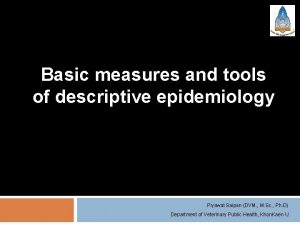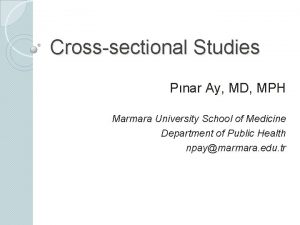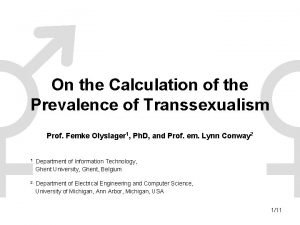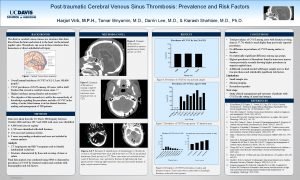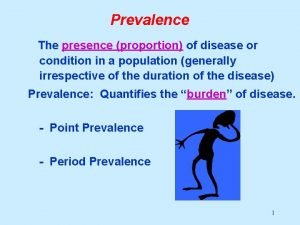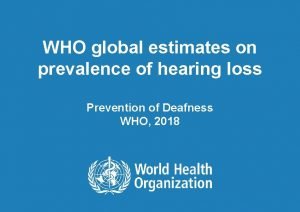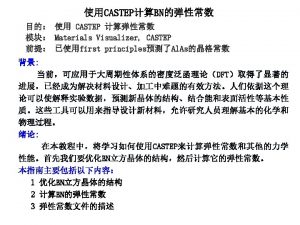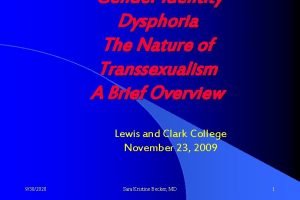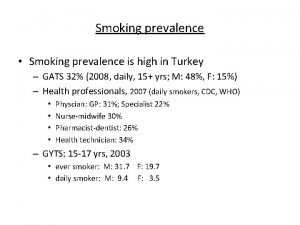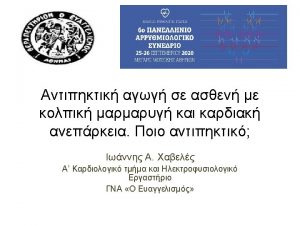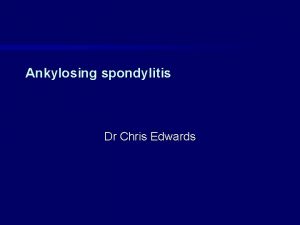On the Calculation of the Prevalence of Transsexualism











- Slides: 11

On the Calculation of the Prevalence of Transsexualism Prof. Femke Olyslager 1, Ph. D, and Prof. em. Lynn Conway 2 1 Department of Information Technology, Ghent University, Ghent, Belgium 2 Department of Electrical Engineering and Computer Science, University of Michigan, Ann Arbor, Michigan, USA 1/11

Introduction • Introductory remark: – Only male-to-female transsexualism is discussed here! • The key-question: “What are the chances that my child is transsexual? ” = “The prevalence of transsexualism. ” • Observation: – Literature(1): P = 1 in 11, 900 – In discrepancy with simple sanity-checks!(2) • Actions: – Analyse the old reports on prevalence – Develop a mathematical framework – Derive commensurable prevalence numbers (1) A. Bakker et al. , “The prevalence of transsexualism in the Netherlands, ” Acta Psych. Scand. , 1993. (2) L. Conway, “How frequently does transsexualism occur? , ” Lynn. Conway. com, 2001. 2/11

Deriving prevalence • • How was prevalence derived? # patients receiving treatment P= total population Problem A: – E. g. the Netherlands(1, 2): 1980 P = 1 in 45, 000 1983 1 in 26, 000 1986 1 in 18, 000 1990 1 in 11, 900 “Prevalence increases over time, as more patients treated. ” • Problem B: – Who is counted? Those satisfying TS definition, those on hormone therapy, those having SRS, . . . ? “Leads to incommensurable numbers. ” (1) A. Bakker et al. , “The prevalence of transsexualism in the Netherlands, ” Acta Psych. Scand. , 1993. (2) P. L. E. Eklund et al. , “Prevalence of transsexualism in the Netherlands, ” Brit. J. Psych. , 1988. 3/11

Deriving prevalence • Types of prevalence: – – – • P(TS) = the prevalence of transsexualism P(SH) = the prevalence of transsexual people who have sought help P(HT) = the prevalence of those on hormone therapy P(ST) = the prevalence of those who have socially transitioned P(SRS) = the prevalence of those who have undergone SRS Inequalities (in general): P(TS) > P(SH) > P(HT) > P(SRS) or: P(TS) > P(SH) > P(ST) > P(HT) > P(SRS) – Allows e. g. to derive P(HT) from P(SRS) if P(SRS)/P(HT) is known – Provides lower bounds for P(TS) 4/11

Deriving prevalence • Suppose transsexuality were visible at birth: • # transsexual babies per year # births per year Suppose transsexuality is always identified at some point in life: P(TS) = # identified individuals per year # births per year – Assumes constant demographics – Assumes regime situation for # identified individuals • Correction for non-constant demographics: P(TS) = # identified individuals per year # births per year L years ago L = average of identification • Note: This is a different from recurring conditions such as the flu, where: P(flu) = # flu cases per year duration flu in days x total population 365 5/11

Inherent vs. active prevalence • “Inherent” prevalence: – P(TSI) = 1 in 4, 000 & population = 4, 000 • 1, 000 identified transsexuals? No! – Age of identification L = 35 years & life expectancy E = 70 years • 500 identified transsexuals! • “Active” prevalence: P(TSA) = • # identified individuals total population Relation between “active” and “inherent” prevalence: _ E L P(TSA) = x P(TSI) E L = average of identification E = life expectancy 6/11

An example • Prevalence as given in Bakker et. al. (1): P(HT in Bakker et. al. (1)) = • 507 patients in 1976 - 1990 = 1 in 11, 900 6, 019, 546 males > 15 years Inherent prevalence: – 34 new patients annually (1, 2) – Average to start HT: L = 32 years – Male births in 1990 – 32 = 1958 (3): 120, 000 # new HT per year 34 = = 1 in 3, 500 # births per year L years ago 120, 000 Active prevalence: P(HTI) = • – If life expectancy E = 75 years, then P(HTA) = E _ E L x P(HTI) = 75 _ 75 32 x 34 = 1 in 6, 200 120, 000 (1) A. Bakker et al. , “The prevalence of transsexualism in the Netherlands, ” Acta Psych. Scand. , 1993. (2) P. L. E. Eklund et al. , “Prevalence of transsexualism in the Netherlands, ” Brit. J. Psych. , 1988. (3) Central bureau for statistics in the Netherlands, http: //www. cbs. nl. 7/11

Other methods • Other methods to estimate the prevalence of transsexualism: “triangulations and sanity-checks” • Example 1: Fellows of the IEEE(1) – 5, 500 Fellows (mostly males) – 3 Fellows had SRS – Estimate: P(SRSA) = 3 = 1 in 1, 800 5, 500 – If P(SRSA) = 1 in 11, 900 then only 1. 6% chance to have 3 cases (1) IEEE: Institute for Electrical and Electronics Engineers. 8/11

Other methods • Example 2: SRS surgeries on US residents(1) – Over 1, 500 SRS on US residents = over 1, 000 SRS in US + over 500 SRS elsewhere – 2, 000 US male births per year P(SRSI) = # SRS per year 1, 500 > > 1 in 1, 300 # births per year 2, 000 – Since P(TSI) > P(SHI) > P(HTI) > P(SRSI): P(TSI) > 1 in 500 (1) L. Conway, “How frequently does transsexualism occur? , ” Lynn. Conway. com, 2001. 9/11

Other methods • Example 3: estimates based on Thai Kathoey – Counting Kathoey (1): 6 per 1, 000 P(STA) = 6 = 1 in 167 1, 000 – Demographic profile of Kathoey (2): 27. 7% of Kathoey had SRS P(SRSA) = 0. 277 x P(STA) = 1 in 600 – Average of SRS L = 24. 1 years & Life expectancy E = 73 years P(SRSI) = 73 x P(SRSA) = 1 in 400 73 _ 24. 1 – Demographic profile of Kathoey (2): 48. 3% of Kathoey who had no SRS want SRS P(TSI) = 1 in 200 (1) S. Winter, “Counting Kathoey, ” Transgender Asia papers, 2002. (2) S. Winter, “Thai Transgenders in focus, Demographics, Transitions and Identities, ” IJT, 2006. 10/11

Conclusions • Past reports failed to answer the key question: “What are the chances that my child is transsexual? ” • Analysis of past reports: P(SRSI) = 1 in 4, 500 to 1 in 2, 000 • P(TSI) = 1 in 2, 000 to 1 in 1, 000 Estimates from more recent reports: P(TSI) = 1 in 500 Transsexuality is not that uncommon! Important for transgender health care and recognition by society! • Further reading (draft hardcopies available from authors): F. Olyslager and L. Conway, “On the Calculation of the Prevalence of Transsexualism, ” submitted to the International Journal of Transgenderism. 11/11
 Period prevalence vs point prevalence
Period prevalence vs point prevalence Period prevalence vs point prevalence
Period prevalence vs point prevalence Epidemiology defination
Epidemiology defination Period prevalence vs point prevalence
Period prevalence vs point prevalence Prevalence calculation
Prevalence calculation Incidence vs incidence rate
Incidence vs incidence rate Measures of association in epidemiology
Measures of association in epidemiology Sinus vein thrombosis prevalence
Sinus vein thrombosis prevalence Ocd prevalence
Ocd prevalence Period prevalence formula
Period prevalence formula Who global estimates on prevalence of hearing loss 2020
Who global estimates on prevalence of hearing loss 2020 Ego-syntonic
Ego-syntonic
